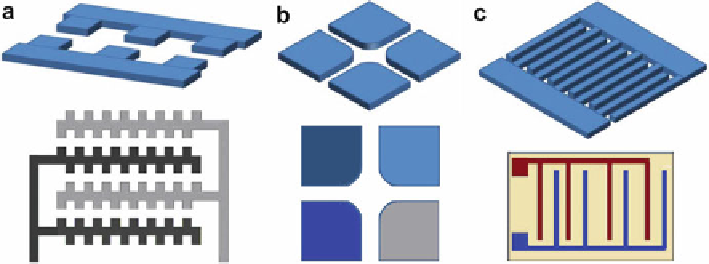Environmental Engineering Reference
In-Depth Information
ineffective, but in the micrometer (and submicrometer) scale, the electrical forces
dominate [
9
].
As a recently introduced technique, microfluidics involves the manipulation of
fluids and particles using dielectrophoresis within a microscale chip. Physical
parameters that characterize microfluidics include Reynolds number, diffusion,
fluidic resistance, surface area to volume ratio, and surface tension [
7
]. Within
microfluidic systems, the manipulation of particles is of fundamental importance
and the characterization of particles within microfluidic systems provides a quan-
titative and analytical approach to interrogate the physicochemical properties of
particles, such as size, permittivity, and conductivity. In terms of nanoparticle
handling, a number of different methods can be combined to produce a complex
technological platform [
6
-
8
].
Nanoparticle manipulation and separation have been achieved using a wide
range of different electrode configurations, the three classical electrode configura-
tions that have been used for DEP manipulation being castellated electrodes,
polynomial electrodes, and interdigitated or parallel finger paired electrode array,
schematically presented in Fig.
14.1
[
6
,
9
,
11
]:
For example, nanometer sized particles can be both stably trapped in
nanofabricated electrode arrays and, more importantly, a heterogeneous mixture
can be separated into two populations using dielectrophoresis. By varying electrode
shape and applied voltage, DEP forces have been used for particle trapping,
arraying, levitation, translation, fractionation, filtration, orientation, and character-
ization based on dielectric properties. A parallel, planar, interdigitated electrode
array is depicted in Fig.
14.2
[
8
,
14
,
15
]. When a potential is applied across
alternating electrodes, this array establishes a nonuniform electric field dependent
on dimensional and material properties. Particles suspended in a fluid experience a
spatially varying DEP force that governs particle kinetics, being possible to sepa-
rate heterogeneous mixtures comprising a wide range of nanoparticles into constit-
uent particle types.
Fig. 14.1 Schematic of the DEP patterning chamber: classical interdigitated castellated micro-
electrode pattern (a), polynomial electrodes (b), and parallel finger paired electrodes (c)

